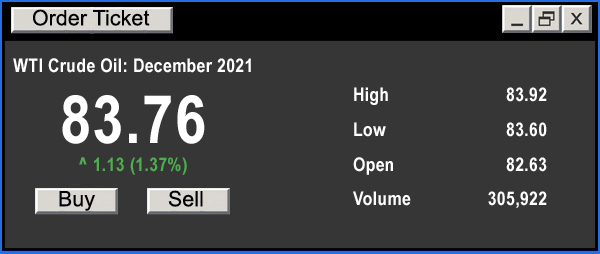What are Futures?
Everyone knows of the stock market; fewer are aware of the futures markets, their purpose, and their function. Suppose one believes a company, or a company set in an index or ETF, are potentially going to increase in value. In that case, they can purchase shares of those companies at their current price and then hold those shares for a given time before hopefully selling them for profit if the value increases. But what if someone wanted to employ that strategy, not to a specific company, but the price of a commodity, currency, financial instrument, or stock index at a future date? What if they wanted to invest in the movement of crude oil prices, for instance?
If that person is not established in the physical crude oil market with something like a refinery or a well, their choices are limited. It is not exactly feasible to order several barrels of crude to one’s house, hold it in the garage for a few months, then try to sell it for a higher price. Futures trading is an alternative investment vehicle that allows an investor to participate in these potential price movements by buying and selling futures contracts without having to buy or sell the underlying commodity.
Here is where futures differ from stocks. Stocks are securities, so when a company’s shares are purchased, the investor gains actual percentage ownership of the company. Futures, on the other hand, are derivative financial contracts. Buying a futures contract does not grant ownership of the underlying commodity, and selling a futures contract does not grant ownership of the capital from that sale. You are entering into a contract to buy or sell at a given price at a future date.
Anatomy of a Futures Contract
Before taking a venture into futures trading, it is important to focus on the anatomy of a futures contract. First is the asset class underlying the contract. Since futures are a derivative, there is always an underlying commodity from which the contract derives its value. Asset classes include, but are not limited to, energies such as crude oil, agricultural commodities such as corn and soybeans, and precious metals such as gold or silver. Futures’ underlying assets even include non-commodity products such as currency futures, treasuries such as bonds, and equity indices like the S&P 500.
The next piece of a futures contract is the quantity or size of the contract: how much of the underlying asset is being bought or sold when the contract is entered? For that crude oil contract, the size for both US WTI light sweet crude (CL) futures contract and UK Brent crude (QA) futures contract is 1000 barrels per contract, with the prices quoted in U.S. dollars and cents per barrel. There are several different contracts with varying quantities for some asset classes, such as the S&P 500 stock index. A full-size S&P 500 (SP) futures contract is $250 multiplied by S&P 500 index price, while the commonly traded E-mini S&P 500 (ES) futures contract is $50 multiplied by the S&P 500 index price. The Chicago Mercantile Exchange recently launched a series of micro E-mini futures. The Micro E-Mini S&P 500 (MES) futures contract size is $5 multiplied by the value of the S&P 500 index.
The next important component of a futures contract’s anatomy is the expiration or delivery date. As the name suggests, a futures contract is an agreement to purchase or sell the underlying commodity at a future date at a predetermined price. The expiry date marks the final day the contract can be traded, and by extension, after the expiry date, the contract must be settled according to the terms of the agreement. For example, if the expiry date, also known as the delivery date, is reached on one contract of WTI crude oil, then the buyer and seller will exchange the asset or cash value equivalent according to the terms of settlement for the contract.
Other aspects that will often appear when viewing a futures price quote include the abbreviated symbol for the contract, as well as basic data for that contract. This includes the current strike price, which represents what the buyer would pay per unit, the high and low prices for the day, the opening price, and the settled closing price for the end of the last trading sessions. In addition to price data, quotes are also often listed with the volume, which is the number of contracts traded during the session, and the open interest, which is the number of outstanding contracts. A contract is considered open when a trader has executed a buy or sell, having not yet closed the trade by entering a contract with an opposite leg.
Example:
Below is a hypothetical example for a futures order ticket. It includes the contract name, WTI Crude Oil (Symbol: CL), with a December expiration. The ticket includes the last price, the opening, low and high prices for the trading session, and the volume. Most futures quotes also include the change for that day’s trading session (up 1.13 or 1.37%).

Futures Exchanges
- Chicago Board of Trade (CBOT)
- Chicago Mercantile Exchange (CME / GLOBEX)
- Intercontinental Exchange (ICE)
- Kansas City Board of Trade (KCBT)
- London Metal Exchange (LME)
- New York Board of Trade (NYBOT)
- New York Mercantile Exchange (NYMEX / COMEX)
Trading Hours
Futures exchanges set trading hours for each contract. These hours were once limited to when open outcry trading floors were active, but electronic clearing has expanded these hours greatly. E-mini Futures trading hours for most contracts are close to 24/5. For example, E-mini S&P (ES) futures trading hours are from 5pm on Sunday evening until 4pm on Friday afternoon, with a break every day from 4pm-5pm (Chicago time). Most exchanges have holiday hours as well, halting trading on certain holidays.
Trading Futures
Included in the order ticket, along with the relevant information for the contract, is the option to buy or sell. Buying a futures contract is called taking on a long position, while selling is called taking a short position or “shorting” the contract. Waiting for the futures contract to expire allows one to accept delivery of the underlying asset at the price the contract was originally purchased, but most futures trades end with the trader taking on an equivalent offsetting position.
For instance, if a trader chose to place a buy order for one WTI Crude Oil (CL) contract with a December expiration and received their fill at the price of 83.76, they would have an open long position. They have entered into a binding agreement to purchase CL at 83.76 when the expiration date comes, regardless of the actual value of the underlying asset at that date. This means that for profit to occur on this contract, CL must increase in value before the expiration date. In contrast, a short position, or a sell, is a trader predicting that the contract will decrease in value.
A few days pass, and the new price of CL is 84.76. The contract has increased in value by $1.00. The trader now wishes to close their position and collect their profits. In order to do this, they take on a short position and receive the current fill price. A trader cannot have both a short and a long position at the same time as they offset one another. Now the trader would be considered “flat” and has profited (not including any applicable commissions or fees) $1,000 from the trade, which represents the $1.00 per barrel price move multiplied by 1,000 as each contract represents 1,000 barrels of WTI Crude Oil.
Margin and Leverage
One detail left out of the above example is the fact that before the trade was offset, the value of the original position, based on the size of a single contract, was $83,760. This is 33% more than the 2018 median household income in the United States, which seems to present an enormous barrier of entry to trade futures. The majority of people do not have that kind of cash sitting around even to begin trading. Fortunately, futures trading involves something called margin, which, although futures trading is still not suitable for everyone, does lower the initial barrier of entry to open a futures contract. This is not to be confused with margin in securities accounts, which has a different meaning.
Margin exists in part because of the nature of futures trading and the reality that most traders never intend to accept delivery on a contract. Using the example above, the trader does not actually plan on purchasing almost $84k in crude oil when December rolls around but instead offsets that position with a sale, profiting or losing based on the price move. Therefore, when the trader opens that initial position, they need only a good-faith down-payment, a deposit known as the margin requirement. Margin rates vary and tend to be between 5% and 15% of the total contract value, depending on the contract.
Margin in futures is set at two levels: initial margin and maintenance margin. Initial margin is the cash reserves needed in an account to open a futures position, while the maintenance margin is the minimum level an account balance may fall before a deposit is required to return it to the initial margin level. For example, if the initial margin for the CL position was around 7-8% of the commodity value, let’s say $6,375, then to buy one contract of December CL, the trader would need that $6,375 as opposed to the full $83,760. If the maintenance margin was $5,100, then a drop in the CL substantial enough to bring the account balance below that level would trigger a margin call, requiring a deposit to recoup the balance to the initial margin level of $6,375. In the example above, this would require the December CL to drop by more than $1.28 per barrel to below $82.48, based on a $1.28 move multiplied by a $1,000 multiplier resulting in a $1,280 loss on the contract.
The margin structure for futures trading gives the investor an incredible amount of leverage when trading. In the example given above in Trading Futures, a $1.00 price move resulted in a $1,000 cash gain when the position closed; a 15.7% gain on a single trade when factoring in the $6,375 initial deposit. Conversely, in the maintenance margin example, a $1.28 price move resulted in a $1,280 loss or 20%. Leverage is the ability to control a considerable asset value with a relatively small amount of capital. Leverage in futures provides the investor with immense upside potential while also creating a substantial risk of loss. An important part of understanding the risks involved in trading futures is that the leverage can result in a trader losing more than they invest and that futures trading is not suitable for all investors.
Hedgers vs Speculators
The examples given above most likely describe a speculator: a trader who does not own an equivalent cash position in the contract’s underlying asset, but instead desires a chance to profit by predicting moves in that asset. The leverage provided by futures markets allows many retail traders to make these speculative trades while in turn providing increased liquidity and price stabilization by adding trading volume to the market.
The second purpose of the futures market is also another aspect of that price stabilization. Hedging is the use of a derivative asset class to mitigate risk for a cash position in the underlying asset. This tactic is most often utilized by businesses involved in the buying or selling of the underlying asset. Most cases of hedging futures are reasonably intuitive: a corn farmer with large inventories of the grain would suffer substantial loss if the price of corn dropped before they could sell their supplies. Therefore, they take on an equivalent short position in the corn futures market to limit the net effect of price moves. If the value of their physical corn decreases, the value of their short position increases, thus offsetting much of their exposure to price fluctuations. This maintenance of price volatility goes both ways. Theoretically, the price of corn could skyrocket, increasing the value of the farmer’s cash position. The short futures position, however, would correspondingly suffer a loss. For the hedger, going flat with a hedge that, in hindsight, was unnecessary is preferable to the crippling risk of loss in a naked cash position.
The initial purpose of futures markets was this type of commodity hedging, both for sellers of the underlying commodity and potential buyers, such as a grain processing facility that has to purchase corn to turn into cereals. For that business, an increase in the value of corn would result in a loss, so hedging in futures in that instance would involve a long position. With the advent of non-commodity futures products, more hedging avenues have been opened. For example, if a stock trader has $150,000 in the S&P 500 and fears a bearish trend on the horizon, they can take an equivalent short position using S&P 500 futures to mitigate that risk.
Summary
Futures trading provides benefits to investors seeking an alternative investment to diversify their portfolio, speculative traders looking for an investment vehicle that allows them to utilize leverage, and large-scale producers or consumers of commodities looking to hedge against price volatility. The leverage afforded to futures traders allows for significant upside potential accompanied by significant risk of loss. Understanding the risks involved in trading futures is important, as is only trading with risk capital (money that you can afford to lose). That being said, futures trading might be a good alternative investment for you to explore.
The information provided in the WCA Education Center does not, and is not intended to, constitute financial advice and all information, content, and materials available in the WCA Education Center are for general informational purposes only. This information may not constitute the most up-to-date information. The WCA Education Center may contain information from or links to other third-party websites. Such links are only for the convenience of the reader, user or browser; World Cup Advisor and its affiliates do not recommend or endorse the contents of any third-party sites.
Trading futures and forex involves significant risk of loss and is not suitable for everyone. Past performance is not necessarily indicative of future results.




